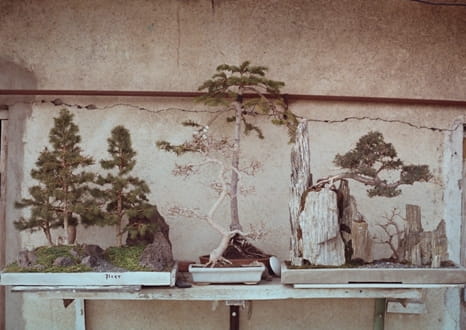From the beginning. When I started working with bonsai, I had only one book, and I often say that due to the lack of the internet at that time, I wasted a lot of time figuring out how to create a bonsai. I did not expect instant results, I just needed the right direction. I quickly learned how to properly transplant deciduous plants, prune branches, trim, and wire. It took me longer to understand the "character" of coniferous plants. However, properly managing the formation, which is the most important and crucial aspect of bonsai culture, turned out to be quite difficult to grasp. It is important to understand that only a plant that is planted in the right pot and naturally shaped beautifully is a bonsai, and not just a small plant in a small pot.

A few years later, when the internet became accessible in Georgia, watching photos and videos of works by experienced specialists yielded results. Gradually, I seemed to understand certain principles for plant formation. There is no doubt that video and photo material is quite a good guide for a beginner enthusiast.
However, I think that learning bonsai formation solely by watching video-photo materials on the internet is incomplete. First of all, it’s difficult for a beginner to tell if the video material was posted by an experienced specialist or by someone who thinks they "have the right" to teach others how to make bonsai. Not only in Georgia, but abroad too, there are many enthusiasts who, after 3-4 years of work, think they already know bonsai formation so well that they can "teach" others. You will often come across such videos on YouTube on various bonsai "specialist" channels.
It is also noteworthy that you will very rarely see a picture of what happened to that seedling even just one year after formation. Because no one posts a video or photo after an unsuccessful result. It would be better if you first look at the works done by this person, and only after that decide whether or not it is worth sharing their experience. Do not rely solely on information you have seen or read once, and make sure to verify it through several trusted sources. It is essential to view many different photos and videos. Especially reading educational articles.
It should also be noted that beginners are often "deceived" by the apparent simplicity of how an experienced specialist forms a bonsai, and seeing this, they think they will achieve the same results very soon. In videos posted online, there is almost never an explanation of the "details" that are essential to know in order for the plant not to get ruined and for the formation process to proceed correctly. Therefore, to achieve the desired result, years of practical experience are necessary. The beginner enthusiast must recognize their own mistakes, analyze them, and draw the right conclusions.
Very often, questions arise: "What should I do now?", "When should I repot?", "When should I prune the branches so the plant doesn’t dry out?"… and so on. Asking questions like these will not lead to any results. A beginner must read and thoroughly learn everything related to bonsai: branch pruning, trimming, wiring, repotting. They must understand watering and other care conditions. They should know when during the year each action should be performed and only then begin working on the bonsai.
So, for a person who wants to seriously engage in the culture of bonsai, it is essential to:
1) Gain a lot of theoretical knowledge
2) Engage in practical, multi-year work to understand bonsai
3) Verify any type of information and determine how qualified your "online teacher" is
Without these three points, it is practically impossible for someone to achieve any success in the culture of bonsai, probably just like in any other field...

